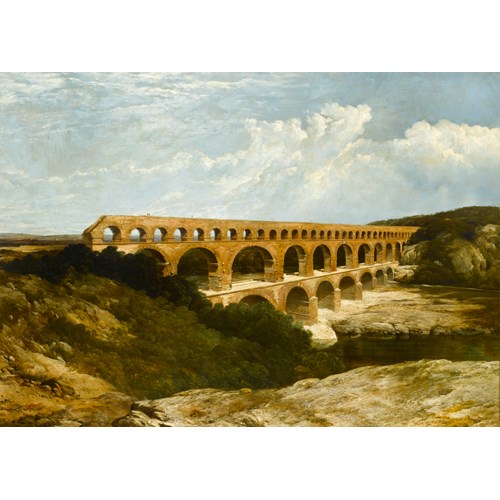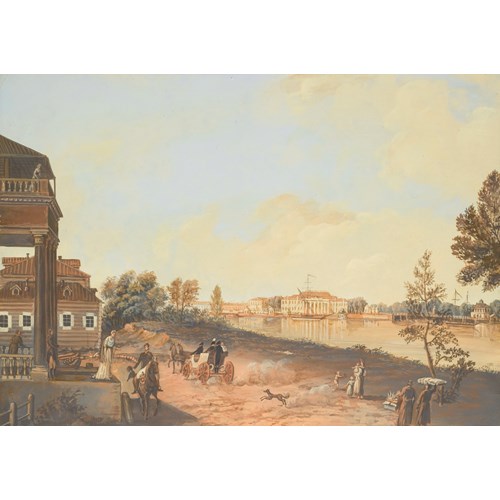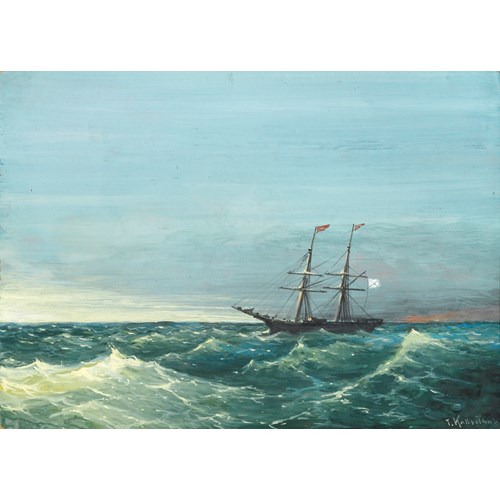Marketplace
Portrait of a Girl with a Dog
Domenico Maggiotto
Portrait of a Girl with a Dog
Epoque 1750-1850, 18th century
Origine Italy
Medium Oil on canvas
Dimension 73 x 56.5 cm (28³/₄ x 22¹/₄ inches)
Prof. Lino Moretti has confirmed the attribution to Maggiotto and points out that when the painting was in The Hague, c. 1930, it hung with a pendant portrait of a girl holding a string of pearls with a jewel casket beside her. We are grateful to Prof. Moretti for his assistance with this painting.
This delicate and sensuous portrait by Domencio Maggiotto of a young woman offering a treat to her dog gives the impression that one is viewing a private scene in which the subject is unaware that she is being observed. The girl’s bodice has partially slipped off her shoulder, revealing an expanse of creamy white flesh and a careless attitude in dress that further conveys the intimacy of the scene. The painting has a dreamy quality accentuated by the soft colour palette and sensitive moulding of the sitter’s features. Her gaze is directed outside of the picture indicating her thoughts are elsewhere as she absent-mindedly strokes her dog with one hand while holding its reward just out of reach in the other.
Maggiotto’s technique of representing figures was adopted from his teacher Giovanni Battista Piazzetta, whose best-known painting, Fortune Teller, in the Accademia, Venice, depicts the protagonist coyly glancing downwards and away like the present sitter. Piazzetta’s characteristically limited colour scheme and prominent use of chiaroscuro, also clearly impacted his pupil’s work. The distinctive handling of paint in depicting the girl’s dress and blue wrap in the present painting is replicated in a work by Maggiotto in the Rijksmuseum, Amsterdam, which portrays a fruit seller holding a basket of apples while conversing with a young man. The two compositions are similar in format, both being half-length and focusing on a young woman posed against a plain dark background. The shadowing in the Rijksmuseum image is particularly intense, giving the two figures a swarthy appearance, in comparison to the glowing complexion of the sitter in the present painting.
Portrait of a Girl with a Dog appears to be less a conventional portrait than a study of facial type and expression and an exploration of the play of light on the girl’s skin and clothing. In this way, it may have been intended as an artistic exercise and investigation into human nature, in the style of Rembrandt’s tronies. Rembrandt was particularly esteemed in eighteenth-century Venice, and if Maggiotto was not directly influenced by his work, he may have been aware of it through his association with the painter Giuseppe Nogari who painted in a similar style. Maggiotto is known to have executed paintings solely intended as character types as he contributed to a group of thirty such images that were commissioned from leading Venetian artists by the Visconti family. These studies of personality types were hugely popular at the time, and formed a significant part of eighteenth-century figurative painting, although they were given minor status within the traditional classification of painting.
Maggiotto studied under Piazzetta from the age of ten and assisted in his studio until Piazzetta’s death in 1754, a long association that no doubt explains the parallels in their work. During this period, Maggiotto mainly executed genre scenes and collaborated on Piazzetta’s large scale historical and religious works. Piazzetta was particularly well-known for his drawings of half-length figures and heads documenting the common people of Venice, works which played a prominent part in increasing the status of drawing to an independent art form. Maggiotto imitated his master by producing a number of drawings in coloured chalks, which were very much works of art in themselves rather than preparatory studies. In the years following Piazzetta’s death, Maggiotto employed an eclectic range of styles and began painting altarpieces, although he continued to do his best work in smaller formats. In 1756, he was elected to the Accademia di Belle Arti, Venice, after which his work took on a more classicising style and he ventured into moralising and historical narratives in addition to his regular output of genre scenes. Maggiotto was also a noted restorer of paintings.
This delicate and sensuous portrait by Domencio Maggiotto of a young woman offering a treat to her dog gives the impression that one is viewing a private scene in which the subject is unaware that she is being observed. The girl’s bodice has partially slipped off her shoulder, revealing an expanse of creamy white flesh and a careless attitude in dress that further conveys the intimacy of the scene. The painting has a dreamy quality accentuated by the soft colour palette and sensitive moulding of the sitter’s features. Her gaze is directed outside of the picture indicating her thoughts are elsewhere as she absent-mindedly strokes her dog with one hand while holding its reward just out of reach in the other.
Maggiotto’s technique of representing figures was adopted from his teacher Giovanni Battista Piazzetta, whose best-known painting, Fortune Teller, in the Accademia, Venice, depicts the protagonist coyly glancing downwards and away like the present sitter. Piazzetta’s characteristically limited colour scheme and prominent use of chiaroscuro, also clearly impacted his pupil’s work. The distinctive handling of paint in depicting the girl’s dress and blue wrap in the present painting is replicated in a work by Maggiotto in the Rijksmuseum, Amsterdam, which portrays a fruit seller holding a basket of apples while conversing with a young man. The two compositions are similar in format, both being half-length and focusing on a young woman posed against a plain dark background. The shadowing in the Rijksmuseum image is particularly intense, giving the two figures a swarthy appearance, in comparison to the glowing complexion of the sitter in the present painting.
Portrait of a Girl with a Dog appears to be less a conventional portrait than a study of facial type and expression and an exploration of the play of light on the girl’s skin and clothing. In this way, it may have been intended as an artistic exercise and investigation into human nature, in the style of Rembrandt’s tronies. Rembrandt was particularly esteemed in eighteenth-century Venice, and if Maggiotto was not directly influenced by his work, he may have been aware of it through his association with the painter Giuseppe Nogari who painted in a similar style. Maggiotto is known to have executed paintings solely intended as character types as he contributed to a group of thirty such images that were commissioned from leading Venetian artists by the Visconti family. These studies of personality types were hugely popular at the time, and formed a significant part of eighteenth-century figurative painting, although they were given minor status within the traditional classification of painting.
Maggiotto studied under Piazzetta from the age of ten and assisted in his studio until Piazzetta’s death in 1754, a long association that no doubt explains the parallels in their work. During this period, Maggiotto mainly executed genre scenes and collaborated on Piazzetta’s large scale historical and religious works. Piazzetta was particularly well-known for his drawings of half-length figures and heads documenting the common people of Venice, works which played a prominent part in increasing the status of drawing to an independent art form. Maggiotto imitated his master by producing a number of drawings in coloured chalks, which were very much works of art in themselves rather than preparatory studies. In the years following Piazzetta’s death, Maggiotto employed an eclectic range of styles and began painting altarpieces, although he continued to do his best work in smaller formats. In 1756, he was elected to the Accademia di Belle Arti, Venice, after which his work took on a more classicising style and he ventured into moralising and historical narratives in addition to his regular output of genre scenes. Maggiotto was also a noted restorer of paintings.
Epoque: 1750-1850, 18th century
Origine: Italy
Medium: Oil on canvas
Dimension: 73 x 56.5 cm (28³/₄ x 22¹/₄ inches)
Provenance: Private Collection, the Hague, c. 1930
Christie's; sale, 28th Oct. 1977, lot 111, (as Antonio Bellucci).
Plus d'œuvres d'art de la Galerie









, in a Green Dress and Pearls, Standing at a Draped _T638990626119457264.jpg?width=500&height=500&mode=pad&scale=both&qlt=90&format=jpg)